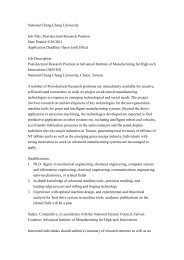Guide to Research and Innovation Strategies for Smart Specialisation
Guide to Research and Innovation Strategies for Smart Specialisation
Guide to Research and Innovation Strategies for Smart Specialisation
You also want an ePaper? Increase the reach of your titles
YUMPU automatically turns print PDFs into web optimized ePapers that Google loves.
Social innovation<br />
Why should social innovation be part of smart specialisation?<br />
Social innovation is important <strong>for</strong> regional development, as it can create new business<br />
opportunities, provide new perspectives <strong>to</strong> citizens, <strong>and</strong> help the modernisation of the public<br />
sec<strong>to</strong>r. It can also be a vehicle <strong>for</strong> making policies more responsive <strong>to</strong> social change <strong>and</strong> <strong>to</strong><br />
encourage <strong>and</strong> support innovative social enterprises. 'Social innovations are innovations that<br />
are social in both their ends <strong>and</strong> their means. Specifically, we define social innovations as new<br />
ideas (products, services <strong>and</strong> models) that simultaneously meet social needs (more effectively<br />
than alternatives) <strong>and</strong> create new social relationships or collaborations. In other words, they<br />
are innovations that are both good <strong>for</strong> society <strong>and</strong> enhance society’s capacity <strong>to</strong> act.' 164<br />
Social innovation is about developing new <strong>for</strong>ms of organisation <strong>and</strong> interactions <strong>to</strong> respond<br />
<strong>to</strong> social/societal issues. They address a social dem<strong>and</strong> or need (e.g. elder care), contribute <strong>to</strong><br />
addressing a societal challenge (ageing society) <strong>and</strong>, through their process dimension (e.g. the<br />
active engagement of the elder, new services) they contribute <strong>to</strong> reshaping society in the<br />
direction of participation, empowerment, co-creation <strong>and</strong> learning.<br />
For these reasons social innovations offer a way <strong>to</strong> tackle societal challenges when the market<br />
<strong>and</strong> public sec<strong>to</strong>r do not respond effectively <strong>to</strong> the social needs. They also contribute<br />
positively <strong>to</strong> diminish the innovation divide by including end users (including disadvantaged<br />
groups) <strong>and</strong> stakeholders in<strong>to</strong> innovation processes, promoting inclusive growth. There<strong>for</strong>e,<br />
they are a relevant rationale <strong>to</strong> have in mind while designing innovation strategies <strong>for</strong> smart<br />
specialisation.<br />
Social innova<strong>to</strong>rs can come from all walks of life. Social innovations can be developed by<br />
private, public <strong>and</strong> third sec<strong>to</strong>rs, <strong>and</strong> should involve households <strong>and</strong> citizens, i.e. the<br />
quadruple helix, <strong>and</strong> can be implemented at national, regional <strong>and</strong> local level.<br />
Barriers <strong>and</strong> Challenges<br />
Social innovation is a relatively new concept <strong>for</strong> which a theoretical framework is being<br />
developed. There is a risk of it being hampered by insufficient knowledge, limited support of<br />
grass roots, social enterprise <strong>and</strong> social entrepreneurship activities, poor diffusion <strong>and</strong> little<br />
scale-up of good practices, <strong>and</strong> poor methods of impact evaluation. The context <strong>for</strong><br />
developing social innovations is very different across European countries' welfare regimes<br />
(i.e. the relative role of state, market, family).<br />
Social innovation challenges traditional structures, <strong>for</strong>ms of organisation <strong>and</strong> power relations,<br />
which are difficult <strong>and</strong> slow <strong>to</strong> change. New <strong>for</strong>ms of engaging with employees, end-users or<br />
citizens, NGOs <strong>and</strong> local communities, making better use of their innovation potential<br />
through e.g. co-creation, workplace innovation or quadruple helix models (including civil<br />
society), can be powerful <strong>to</strong>ols <strong>for</strong> innovation but require considerable mentality change.<br />
Access <strong>to</strong> finance can also constitute a barrier. For example, social enterprises may not have<br />
as easy an access <strong>to</strong> finance from banks as other enterprises. Projects need <strong>to</strong> be encouraged <strong>to</strong><br />
164 Social <strong>Innovation</strong> Exchange <strong>and</strong> Young Foundation 2010 Study on social innovation <strong>for</strong> BEPA.<br />
108

















